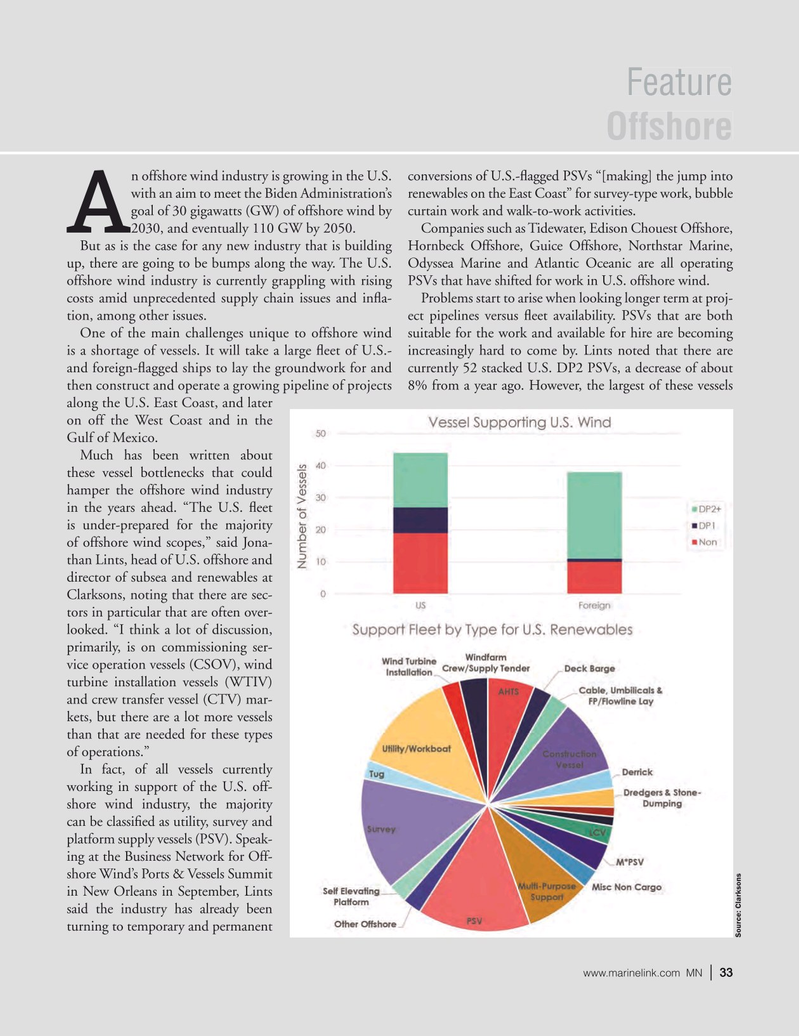
Page 33: of Marine News Magazine (October 2023)
Offshore Energy
Read this page in Pdf, Flash or Html5 edition of October 2023 Marine News Magazine
Offshore n offshore wind industry is growing in the U.S. conversions of U.S.-? agged PSVs “[making] the jump into with an aim to meet the Biden Administration’s renewables on the East Coast” for survey-type work, bubble goal of 30 gigawatts (GW) of offshore wind by curtain work and walk-to-work activities.
A 2030, and eventually 110 GW by 2050. Companies such as Tidewater, Edison Chouest Offshore,
But as is the case for any new industry that is building Hornbeck Offshore, Guice Offshore, Northstar Marine, up, there are going to be bumps along the way. The U.S. Odyssea Marine and Atlantic Oceanic are all operating offshore wind industry is currently grappling with rising PSVs that have shifted for work in U.S. offshore wind.
costs amid unprecedented supply chain issues and in? a- Problems start to arise when looking longer term at proj- tion, among other issues. ect pipelines versus ? eet availability. PSVs that are both
One of the main challenges unique to offshore wind suitable for the work and available for hire are becoming is a shortage of vessels. It will take a large ? eet of U.S.- increasingly hard to come by. Lints noted that there are and foreign-? agged ships to lay the groundwork for and currently 52 stacked U.S. DP2 PSVs, a decrease of about then construct and operate a growing pipeline of projects 8% from a year ago. However, the largest of these vessels along the U.S. East Coast, and later on off the West Coast and in the
Gulf of Mexico.
Much has been written about these vessel bottlenecks that could hamper the offshore wind industry in the years ahead. “The U.S. ? eet is under-prepared for the majority of offshore wind scopes,” said Jona- than Lints, head of U.S. offshore and director of subsea and renewables at
Clarksons, noting that there are sec- tors in particular that are often over- looked. “I think a lot of discussion, primarily, is on commissioning ser- vice operation vessels (CSOV), wind turbine installation vessels (WTIV) and crew transfer vessel (CTV) mar- kets, but there are a lot more vessels than that are needed for these types of operations.”
In fact, of all vessels currently working in support of the U.S. off- shore wind industry, the majority can be classi? ed as utility, survey and platform supply vessels (PSV). Speak- ing at the Business Network for Off- shore Wind’s Ports & Vessels Summit in New Orleans in September, Lints said the industry has already been turning to temporary and permanent
Source: Clarksons www.marinelink.com MN 33|

 32
32

 34
34
